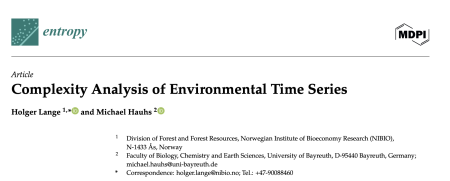
Resource description:
Small, forested catchments are prototypes of terrestrial ecosystems and have been studied in several disciplines of environmental science over several decades. Time series of water and matter fluxes and nutrient concentrations from these systems exhibit a bewildering diversity of spatiotemporal patterns, indicating the intricate nature of processes acting on a large range of time scales. Nonlinear dynamics is an obvious framework to investigate catchment time series. We analyzed selected long-term data from three headwater catchments in the Bramke valley, Harz mountains, Lower Saxony in Germany at common biweekly resolution for the period 1991 to 2023. For every time series, we performed gap filling, detrending, and removal of the annual cycle using singular system analysis (SSA), and then calculated metrics based on ordinal pattern statistics: the permutation entropy, permutation complexity, and Fisher information, as well as their generalized versions (q-entropy and α-entropy). Further, the position of each variable in Tarnopolski diagrams is displayed and compared to reference stochastic processes, like fractional Brownian motion, fractional Gaussian noise, and β noise. Still another way of distinguishing deterministic chaos and structured noise, and quantifying the latter, is provided by the complexity from ordinal pattern positioned slopes (COPPS). We also constructed horizontal visibility graphs and estimated the exponent of the decay of the degree distribution. Taken together, the analyses create a characterization of the dynamics of these systems which can be scrutinized for universality, either across variables or between the three geographically very close catchments.
Author/Contact:
Holger Lange, Michael Hauhs for Entropy.